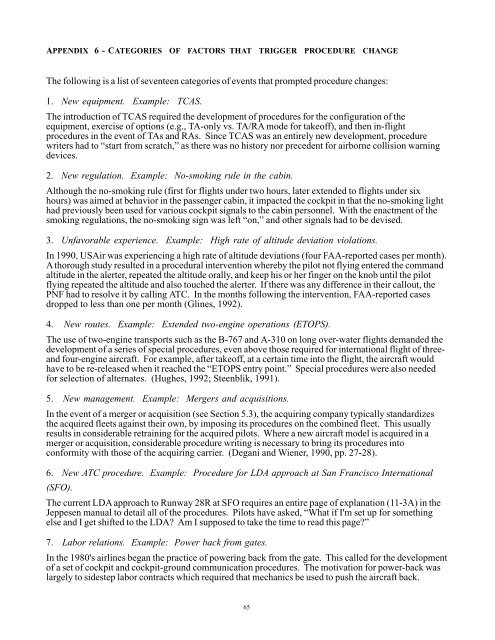On the Design of Flight-Deck Procedures - Intelligent Systems ...
On the Design of Flight-Deck Procedures - Intelligent Systems ...
On the Design of Flight-Deck Procedures - Intelligent Systems ...
Create successful ePaper yourself
Turn your PDF publications into a flip-book with our unique Google optimized e-Paper software.
APPENDIX 6 - CATEGORIES OF FACTORS THAT TRIGGER PROCEDURE CHANGEThe following is a list <strong>of</strong> seventeen categories <strong>of</strong> events that prompted procedure changes:1. New equipment. Example: TCAS.The introduction <strong>of</strong> TCAS required <strong>the</strong> development <strong>of</strong> procedures for <strong>the</strong> configuration <strong>of</strong> <strong>the</strong>equipment, exercise <strong>of</strong> options (e.g., TA-only vs. TA/RA mode for take<strong>of</strong>f), and <strong>the</strong>n in-flightprocedures in <strong>the</strong> event <strong>of</strong> TAs and RAs. Since TCAS was an entirely new development, procedurewriters had to “start from scratch,” as <strong>the</strong>re was no history nor precedent for airborne collision warningdevices.2. New regulation. Example: No-smoking rule in <strong>the</strong> cabin.Although <strong>the</strong> no-smoking rule (first for flights under two hours, later extended to flights under sixhours) was aimed at behavior in <strong>the</strong> passenger cabin, it impacted <strong>the</strong> cockpit in that <strong>the</strong> no-smoking lighthad previously been used for various cockpit signals to <strong>the</strong> cabin personnel. With <strong>the</strong> enactment <strong>of</strong> <strong>the</strong>smoking regulations, <strong>the</strong> no-smoking sign was left “on,” and o<strong>the</strong>r signals had to be devised.3. Unfavorable experience. Example: High rate <strong>of</strong> altitude deviation violations.In 1990, USAir was experiencing a high rate <strong>of</strong> altitude deviations (four FAA-reported cases per month).A thorough study resulted in a procedural intervention whereby <strong>the</strong> pilot not flying entered <strong>the</strong> commandaltitude in <strong>the</strong> alerter, repeated <strong>the</strong> altitude orally, and keep his or her finger on <strong>the</strong> knob until <strong>the</strong> pilotflying repeated <strong>the</strong> altitude and also touched <strong>the</strong> alerter. If <strong>the</strong>re was any difference in <strong>the</strong>ir callout, <strong>the</strong>PNF had to resolve it by calling ATC. In <strong>the</strong> months following <strong>the</strong> intervention, FAA-reported casesdropped to less than one per month (Glines, 1992).4. New routes. Example: Extended two-engine operations (ETOPS).The use <strong>of</strong> two-engine transports such as <strong>the</strong> B-767 and A-310 on long over-water flights demanded <strong>the</strong>development <strong>of</strong> a series <strong>of</strong> special procedures, even above those required for international flight <strong>of</strong> threeandfour-engine aircraft. For example, after take<strong>of</strong>f, at a certain time into <strong>the</strong> flight, <strong>the</strong> aircraft wouldhave to be re-released when it reached <strong>the</strong> “ETOPS entry point.” Special procedures were also neededfor selection <strong>of</strong> alternates. (Hughes, 1992; Steenblik, 1991).5. New management. Example: Mergers and acquisitions.In <strong>the</strong> event <strong>of</strong> a merger or acquisition (see Section 5.3), <strong>the</strong> acquiring company typically standardizes<strong>the</strong> acquired fleets against <strong>the</strong>ir own, by imposing its procedures on <strong>the</strong> combined fleet. This usuallyresults in considerable retraining for <strong>the</strong> acquired pilots. Where a new aircraft model is acquired in amerger or acquisition, considerable procedure writing is necessary to bring its procedures intoconformity with those <strong>of</strong> <strong>the</strong> acquiring carrier. (Degani and Wiener, 1990, pp. 27-28).6. New ATC procedure. Example: Procedure for LDA approach at San Francisco International(SFO).The current LDA approach to Runway 28R at SFO requires an entire page <strong>of</strong> explanation (11-3A) in <strong>the</strong>Jeppesen manual to detail all <strong>of</strong> <strong>the</strong> procedures. Pilots have asked, “What if I'm set up for somethingelse and I get shifted to <strong>the</strong> LDA? Am I supposed to take <strong>the</strong> time to read this page?”7. Labor relations. Example: Power back from gates.In <strong>the</strong> 1980's airlines began <strong>the</strong> practice <strong>of</strong> powering back from <strong>the</strong> gate. This called for <strong>the</strong> development<strong>of</strong> a set <strong>of</strong> cockpit and cockpit-ground communication procedures. The motivation for power-back waslargely to sidestep labor contracts which required that mechanics be used to push <strong>the</strong> aircraft back.65
















